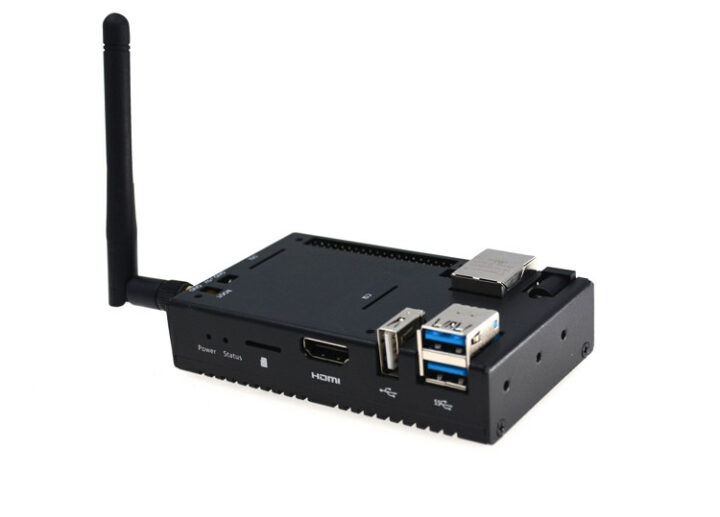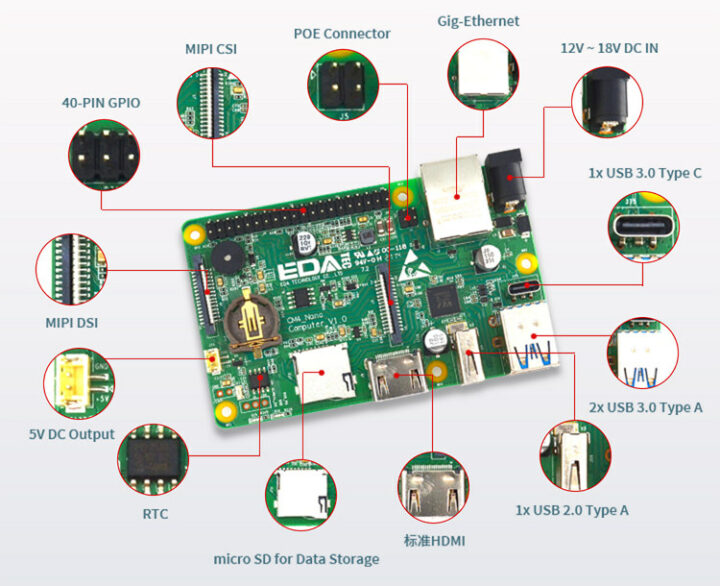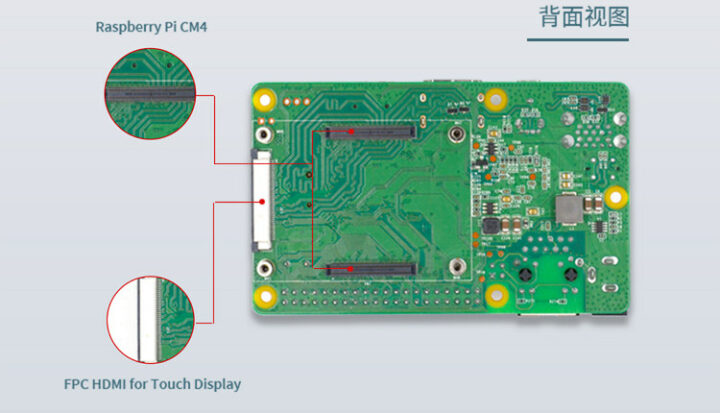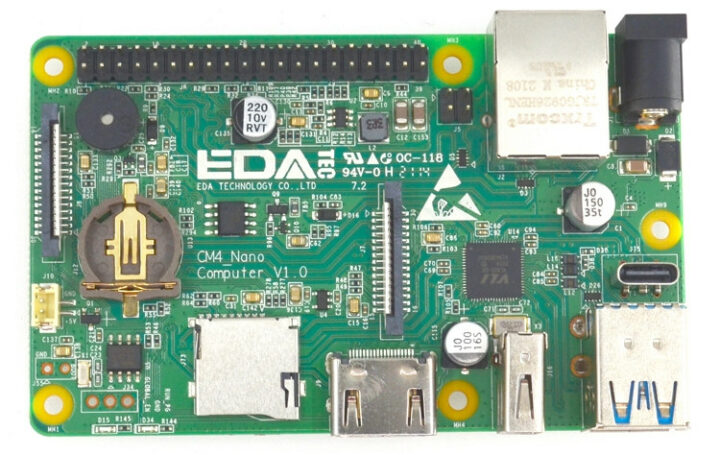If you ever wanted a mini PC similar to Raspberry Pi 4 but working within a wider temperature range and supply voltage, as well as a few extra features, the Raspberry Pi CM4 Nano industrial mini PC with a metal enclosure might be worth looking at.
Based on the EDATEC CM4 Nano carrier board, the mini PC supports Raspberry Pi CM4 with up to 8GB RAM, 32GB storage, optional WiFi 5 and Bluetooth 5.0, and offers one HDMI port, a flat cable HDMI + Touchscreen connector, Gigabit Ethernet, three USB 3.0 ports and more. It works in settings with -25 to +60°C ambient temperature and offers a 12-18V DC input.
EDATEC (Raspberry Pi) CM4 Nano specifications compared to Raspberry Pi 4 SBC:
| Features | EDATEC CM4 Nano | Raspberry Pi 4 |
|---|---|---|
| CPU | Quad-core, Cortex-A72, 1.5GHz ARM v8 64-bit CPU |
|
| RAM | 1GB, 2GB, 4GB, or 8GB | 2GB, 4GB, or 8GB |
| Storage | MicroSD card or eMMC flash (8GB, 16GB, 32GB) | MicroSD card only |
| HDMI | 1x HDMI Type-A port 1x FPC Connector with HDMI and USB (for touchscreen) | 2x micro HDMI ports |
| MIPI DSI | 1x |
|
| MIPI CSI | 1x |
|
| Ethernet | Gigabit Ethernet with optional PoE |
|
| WiFi/BT | Optional WiFi 5 and Bluetooth 5.0 | Built-in WiFi 5 and Bluetooth 5.0 |
| Antenna | PCB antenna and external Antenna | PCB antenna |
| USB | 2x USB 3.0 ports 1x USB 3.0 OTG port 1x USB 2.0 port | 2x USB 3.0 ports 2x USB 2.0 ports |
| 40-pin expansion header | Yes |
|
| RTC | Yes | N/A |
| Buzzer | Yes | N/A |
| LED | Green (System Status), Red (Power indicator) |
|
| Power Input | 12V~18V DC | 5V DC |
| DC output | 5V/2A | N/A |
| Dimensions (PCBA) | 95 x 58 x 24mm | 89 x 56 x 24mm |
| Enclosure | Full metal case with a whole side aluminum alloy heat sink | Official plastic enclosure, wide ecosystem of third-party plastic/metal enclosures |
| Temperature range | -25 to +60°C | 0 to ??°C (unspecified) |
The company uses the Raspberry Pi OS image for the board plus a Board Support Package (BSP) specific to CM4 Nano to support extra features like the RTC:
|
1 2 3 4 |
curl -sS https://apt.edatec.cn/pubkey.gpg | sudo apt-key add - echo "deb https://apt.edatec.cn/raspbian stable main" | sudo tee /etc/apt/sources.list.d/edatec.list sudo apt update sudo apt install ed-cm4nano-bsp ed-rtc |
I’m quite pleased with the documentation after quickly browsing through it, and I wish more boards had this level of details, albeit some of which will look similar to the Raspberry Pi Compute Module 4 documentation. What I did not find is information about the “FPC HDMI connector for touchscreen displays” as it does not look standard to me, so it would be good to have the display there are using,
The Raspberry Pi CM4 Nano mini PC is available on Aliexpress for $112.99 including shipping, excluding taxes. Understanding exactly what you are ordering is not super easy since they use Raspberry Pi CM4 part numbers without any other details. So here’s some help:
- CM4102008 – 2GB RAM, 8GB eMMC flash, wireless module
- CM4101008 – 1GB RAM, 8GB eMMC flash, wireless module
- CM4104008 – 4GB RAM, 8GB eMMC flash, wireless module
- CM4108008 – 8GB RAM, 8GB eMMC flash, wireless module
I understand the mini PC ships with the carrier board, CM4 module, metal enclosure, and antenna, but other accessories like the power supply may not be included.
Thanks to theguyuk for the tip.

Jean-Luc started CNX Software in 2010 as a part-time endeavor, before quitting his job as a software engineering manager, and starting to write daily news, and reviews full time later in 2011.
Support CNX Software! Donate via cryptocurrencies, become a Patron on Patreon, or purchase goods on Amazon or Aliexpress









12 tot 18v, open housing with not even fully enclosed connectors. I do not see why the term ‘industrial’ is applicable. There are better rpi based alternatives that are actually industrial.
Yeah, really strange choices here. And far too expensive for what is is
I was surprised as well by this approach. I suspect that it was only in order to keep the expansion connector accessible without resorting to a riser.
hello thomas, do you have some links to share about those better industrial alternatives?
Having a 24V power input would be better for a lot of industrial applications, and 9-36V would be ideal.